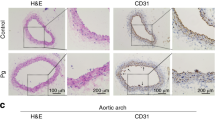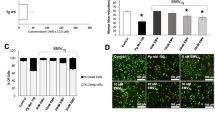Abstract
Recent researches suggest an association between periodontitis and cardiovascular disease. Periodontopathic bacteria and/or their component might play a role in the development of atherosclerotic lesions. In the present study, we investigated in vitro the effect of Porphyromonas gingivalis lipopolysaccharide (LPS) on the expression of adhesion molecules in human umbilical vein endothelial cells (HUVECs) as well as its effect on Escherichia coli LPS-induced response. The effect of P. gingivalis LPS was compared with that of toll-like receptor 2 agonist synthetic triacylated lipoprotein Pam3-Cys-Ser-(Lys)4 (Pam3CSK4). Gene and protein expression of intercellular adhesion molecule-1, vascular cell adhesion molecule-1, and E-selectin were measured using RT-PCR and flow cytometry, respectively. P. gingivalis LPS stimulated the expression levels of all adhesion molecules in a dose-dependent manner. However, the response of HUVECs to P. gingivalis LPS was markedly lower than that to E. coli LPS. Moreover, P. gingivalis LPS attenuated E. coli LPS-induced responses when HUVECs were simultaneously stimulated with both kinds of LPS. Treatment with Pam3CSK4 resulted in a minor increase of adhesion molecule expression and did not diminish E. coli LPS-induced responses. Our data suggest that P. gingivalis LPS induces in vitro the expression of adhesion molecules in endothelial cells, which might promote atherogenesis. Qualitatively different responses of HUVECs to P. gingivalis LPS and Pam3CSK4 suggest that besides TLR2 other signaling pathways might be involved in the effects of P. gingivalis LPS.




Similar content being viewed by others
References
Kinane DF. Causation and pathogenesis of periodontal disease. Periodontol. 2000;2001(25):8–20.
Socransky SS, Haffajee AD, Cugini MA, Smith C, Kent RL Jr. Microbial complexes in subgingival plaque. J Clin Periodontol. 1998;25:134–44.
Epstein SE. The multiple mechanisms by which infection may contribute to atherosclerosis development and course. Circ Res. 2002;90:2–4.
Gibson FC 3rd, Yumoto H, Takahashi Y, Chou HH, Genco CA. Innate immune signaling and Porphyromonas gingivalis-accelerated atherosclerosis. J Dent Res. 2006;85:106–21.
Libby P. Inflammation in atherosclerosis. Nature. 2002;420:868–74.
Lusis AJ. Atherosclerosis. Nature. 2000;407:233–41.
Darveau RP, Cunningham MD, Bailey T, Seachord C, Ratcliffe K, Bainbridge B, Dietsch M, Page RC, Aruffo A. Ability of bacteria associated with chronic inflammatory disease to stimulate E-selectin expression and promote neutrophil adhesion. Infect Immun. 1995;63(4):1311–7.
Takahashi Y, Davey M, Yumoto H, Gibson FC 3rd, Genco CA. Fimbria-dependent activation of pro-inflammatory molecules in Porphyromonas gingivalis infected human aortic endothelial cells. Cell Microbiol. 2006;8:738–57.
Khlgatian M, Nassar H, Chou HH, Gibson FC 3rd, Genco CA. Fimbria-dependent activation of cell adhesion molecule expression in Porphyromonas gingivalis-infected endothelial cells. Infect Immun. 2002;70:257–67.
Nakamura N, Yoshida M, Umeda M, Huang Y, Kitajima S, Inoue Y, Ishikawa I, Iwai T. Extended exposure of lipopolysaccharide fraction from Porphyromonas gingivalis facilitates mononuclear cell adhesion to vascular endothelium via Toll-like receptor-2 dependent mechanism. Atherosclerosis. 2008;196:59–67.
Honda T, Oda T, Yoshie H, Yamazaki K. Effects of Porphyromonas gingivalis antigens and proinflammatory cytokines on human coronary artery endothelial cells. Oral Microbiol Immunol. 2005;20:82–8.
Jain S, Darveau RP. Contribution of Porphyromonas gingivalis lipopolysaccharide to periodontitis. Periodontol. 2000;2010(54):53–70.
Takeda K, Akira S. Toll-like receptors in innate immunity. Int Immunol. 2005;17:1–14.
Hirschfeld M, Weis JJ, Toshchakov V, Salkowski CA, Cody MJ, Ward DC, Qureshi N, Michalek SM, Vogel SN. Signaling by toll-like receptor 2 and 4 agonists results in differential gene expression in murine macrophages. Infect Immun. 2001;69:1477–82.
Martin M, Katz J, Vogel SN, Michalek SM. Differential induction of endotoxin tolerance by lipopolysaccharides derived from Porphyromonas gingivalis and Escherichia coli. J Immunol. 2001;167:5278–85.
Bainbridge BW, Coats SR, Darveau RP. Porphyromonas gingivalis lipopolysaccharide displays functionally diverse interactions with the innate host defense system. Ann Periodontol. 2002;7:29–37.
Chen C, Coats SR, Bumgarner RE, Darveau RP. Hierarchical gene expression profiles of HUVEC stimulated by different lipid A structures obtained from Porphyromonas gingivalis and Escherichia coli. Cell Microbiol. 2007;9:1028–38.
Erridge C, Spickett CM, Webb DJ. Non-enterobacterial endotoxins stimulate human coronary artery but not venous endothelial cell activation via Toll-like receptor 2. Cardiovasc Res. 2007;73:181–9.
Coats SR, Reife RA, Bainbridge BW, Pham TT, Darveau RP. Porphyromonas gingivalis lipopolysaccharide antagonizes Escherichia coli lipopolysaccharide at toll-like receptor 4 in human endothelial cells. Infect Immun. 2003;71:6799–807.
Hirschfeld M, Ma Y, Weis JH, Vogel SN, Weis JJ. Cutting edge: repurification of lipopolysaccharide eliminates signaling through both human and murine toll-like receptor 2. J Immunol. 2000;165:618–22.
Kocgozlu L, Elkaim R, Tenenbaum H, Werner S. Variable cell responses to P. gingivalis lipopolysaccharide. J Dent Res. 2009;88:741–5.
Andrukhov O, Matejka M, Rausch-Fan X. Effect of cyclosporin A on proliferation and differentiation of human periodontal ligament cells. Acta Odontol Scand. 2010;68:329–34.
Sekot G, Posch G, Messner P, Matejka M, Rausch-Fan X, Andrukhov O, Schaffer C. Potential of the Tannerella forsythia S-layer to delay the immune response. J Dent Res. 2011;90:109–14.
Libby P. Changing concepts of atherogenesis. J Int Med. 2000;247:349–58.
Haziot A, Rong GW, Silver J, Goyert SM. Recombinant soluble CD14 mediates the activation of endothelial cells by lipopolysaccharide. J Immunol. 1993;151:1500–7.
Masaka T, Hayashi J, Ishikawa I. Soluble CD14-dependent intercellular adhesion molecular-1 induction by Porphyromonas gingivalis lipopolysaccharide in human gingival fibroblasts. J Periodontol. 1999;70:772–8.
von Asmuth EJ, Leeuwenberg JF, Ceska M, Buurman WA. LPS and cytokine-induced endothelial cell IL-6 release and ELAM-1 expression; involvement of serum. Eur Cyt Network. 1991;2:291–7.
Eppihimer MJ, Wolitzky B, Anderson DC, Labow MA, Granger DN. Heterogeneity of expression of E- and P-selectins in vivo. Circ Res. 1996;79:560–9.
Lubos E, Mahoney CE, Leopold JA, Zhang YY, Loscalzo J, Handy DE. Glutathione peroxidase-1 modulates lipopolysaccharide-induced adhesion molecule expression in endothelial cells by altering CD14 expression. Faseb J. 2010;24:2525–32.
Wada K, Kamisaki Y. Roles of oral bacteria in cardiovascular diseases—from molecular mechanisms to clinical cases: involvement of Porphyromonas gingivalis in the development of human aortic aneurysm. J Pharmacol Sci. 2010;113:115–9.
Coats SR, Pham TT, Bainbridge BW, Reife RA, Darveau RP. MD-2 mediates the ability of tetra-acylated and penta-acylated lipopolysaccharides to antagonize Escherichia coli lipopolysaccharide at the TLR4 signaling complex. J Immunol. 2005;175:4490–8.
Yoshimura A, Kaneko T, Kato Y, Golenbock DT, Hara Y. Lipopolysaccharides from periodontopathic bacteria Porphyromonas gingivalis and Capnocytophaga ochracea are antagonists for human toll-like receptor 4. Infect Immun. 2002;70:218–25.
Hajishengallis G, Martin M, Schifferle RE, Genco RJ. Counteracting interactions between lipopolysaccharide molecules with differential activation of toll-like receptors. Infect Immun. 2002;70:6658–64.
Nichols FC, Bajrami B, Clark RB, Housley W, Yao X. Free lipid A isolated from Porphyromonas gingivalis lipopolysaccharide is contaminated with phosphorylated dihydroceramide lipids: recovery in diseased dental samples. Infect Immun. 2012;80:860–74.
Acknowledgments
The study was supported by author’s institution (Bernhard Gottlieb School of Dentistry). The authors thank Mrs. Phuong Quynh Nguyen and Mrs. Hedwig Rutschek for their help in performing the experiments.
Conflict of interest
The authors declare no conflict of interest.
Author information
Authors and Affiliations
Corresponding authors
Additional information
O. Andrukhov and I. Steiner contributed equally.
Rights and permissions
About this article
Cite this article
Andrukhov, O., Steiner, I., Liu, S. et al. Different effects of Porphyromonas gingivalis lipopolysaccharide and TLR2 agonist Pam3CSK4 on the adhesion molecules expression in endothelial cells. Odontology 103, 19–26 (2015). https://doi.org/10.1007/s10266-013-0146-x
Received:
Accepted:
Published:
Issue Date:
DOI: https://doi.org/10.1007/s10266-013-0146-x




